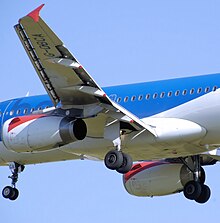|
Wing A wing is a type of fin that produces both lift and drag while moving through air. Wings are defined by two shape characteristics, an airfoil section and a planform. Wing efficiency is expressed as lift-to-drag ratio, which compares the benefit of lift with the air resistance of a given wing shape, as it flies. Aerodynamics is the study of wing performance in air. Equivalent foils that move through water are found on hydrofoil power vessels and foiling sailboats that lift out of the water at speed and on submarines that use diving planes to point the boat upwards or downwards, while running submerged. Hydrodynamics is the study of foil performance in water. Etymology and usageThe word "wing" from the Old Norse vængr[1] for many centuries referred mainly to the foremost limbs of birds (in addition to the architectural aisle). But in recent centuries the word's meaning has extended to include lift producing appendages of insects, bats, pterosaurs, boomerangs, some sail boats and aircraft, or the airfoil on a race car.[2] In natureIn nature wings have evolved in dinosaurs, birds (see Bird wing), mammals, fish, reptiles and plants as means of locomotion.[citation needed] Various species of penguins and other flighted or flightless water birds such as auks, cormorants, guillemots, shearwaters, eider and scoter ducks and diving petrels are efficient underwater swimmers, and use their wings to propel through water.[3]
Aerodynamics  The design and analysis of the wings of aircraft is one of the principal applications of the science of aerodynamics, which is a branch of fluid mechanics. The properties of the airflow around any moving object can be found by solving the Navier-Stokes equations of fluid dynamics. Except for simple geometries, these equations are difficult to solve.[4] Simpler explanations can be given For a wing to produce "lift", it must be oriented at a suitable angle of attack relative to the flow of air past the wing. When this occurs, the wing deflects the airflow downwards, "turning" the air as it passes the wing. Since the wing exerts a force on the air to change its direction, the air must exert a force on the wing, equal in size but opposite in direction. This force arises from different air pressures that exist on the upper and lower surfaces of the wing.[5][6][7] Lower-than-ambient air pressure is generated on the top surface of the wing, with a higher-than ambient-pressure on the bottom of the wing. (See: airfoil) These air pressure differences can be either measured using a pressure-measuring device, or can be calculated from the airspeed] using physical principles—including Bernoulli's principle, which relates changes in air speed to changes in air pressure. The lower air pressure on the top of the wing generates a smaller downward force on the top of the wing than the upward force generated by the higher air pressure on the bottom of the wing. This gives an upward force on the wing. This force is called the lift generated by the wing. The different velocities of the air passing by the wing, the air pressure differences, the change in direction of the airflow, and the lift on the wing are different ways of describing how lift is produced so it is possible to calculate lift from any one of the other three. For example, the lift can be calculated from the pressure differences, or from different velocities of the air above and below the wing, or from the total momentum change of the deflected air. Fluid dynamics offers other approaches to solving these problems—and all produce the same answers if done correctly. Given a particular wing and its velocity through the air, debates over which mathematical approach is the most convenient to use can be mistaken by those not familiar with the study of aerodynamics as differences of opinion about the basic principles of flight.[8] Cross-sectional shapeWings with an asymmetrical cross-section are the norm in subsonic flight. Wings with a symmetrical cross-section can also generate lift by using a positive angle of attack to deflect air downward. Symmetrical airfoils have higher stalling speeds than cambered airfoils of the same wing area[9] but are used in aerobatic aircraft as they provide the same flight characteristics whether the aircraft is upright or inverted.[10] Another example comes from sailboats, where the sail is a thin sheet.[11] For flight speeds near the speed of sound (transonic flight), specific asymmetrical airfoil sections are used to minimize the very pronounced increase in drag associated with airflow near the speed of sound.[12] These airfoils, called supercritical airfoils, are flat on top and curved on the bottom.[13] Design features Aircraft wings may feature some of the following:
Aircraft wings may have various devices, such as flaps or slats, that the pilot uses to modify the shape and surface area of the wing to change its operating characteristics in flight.
ApplicationsBesides fixed-wing aircraft, applications for wing shapes include:[citation needed]
Flexible wingsIn 1948, Francis Rogallo invented the fully limp flexible wing. Domina Jalbert invented flexible un-sparred ram-air airfoiled thick wings. See alsoNatural world:
Aviation:
Sailing: References
External linksWikimedia Commons has media related to Wings.
|



